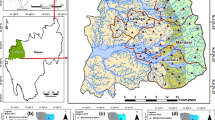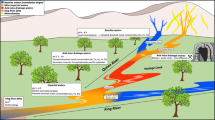Abstract
The use of stable isotope ratios of deuterium (δD) and oxygen (δ18O) together with major ion data can indicate the origins and movement of surface water and groundwater. During this investigation, hydrochemical and stable environmental isotope sampling were used to determine the interaction between the Karoo aquifer and the Witwatersrand aquifer. It was evident that shallower groundwater samples taken from the Karoo aquifer were affected by annual precipitation and had a short residence time, since their isotopic signature was very close to that of rainfall. By contrast, rainfall events had not recharged the Witwatersrand aquifer and had not significantly contributed to the isotopic fingerprint of the deeper aquifer samples. The Karoo aquifer is generally enriched in both δ18O and δD; the deeper Witwatersrand aquifer is more depleted in δ18O and δD. This is explained by their different intake histories and travelling periods. The results also indicate that there is interaction between the Karoo and Witwatersrand aquifer, both where coal mining is present and where it is not.
Zusammenfassung
Stabile-Isotopen-Verhältnisse von Deuterium (δD) und Sauerstoff (δ18O) können in Verbindung mit Daten für Hauptionen Hinweise zur Herkunft und Migration von Oberflächen- und Grundwässern liefern. Im Rahmen der hier vorgestellten Arbeit wurden hydrochemische und stabile Umweltisotopendaten genutzt, um Wechselwirkungen zwischen dem Karoo und dem Witwatersrand Aquifer zu untersuchen. Es zeigte sich, dass die aus geringeren Teufen entnommenen Proben des Karoo Aquifers durch hohe Jahresneubildungsraten und geringe Verweilzeiten gekennzeichnet waren, da ihre Isotopensignatur der von Niederschlagswasser stark ähnelte. Im Gegensatz dazu belegten die aus größeren Teufen entnommenen Proben des Witwatersrand Aquifers, dass Niederschlagsereignisse nicht zur Grundwasserneubildung des tiefer gelegenen Aquifers beitragen und dass der Niederschlag keinen signifikanten Einfluss auf die Isotopenzusammensetzung der Proben hat. Der Karoo Aquifer weist durchgängig sowohl für δ18O als auch für δD Anreicherungseffekte auf, während der tiefere Witwatersrand Aquifer bezüglich δ18O und δD abgereichertist. Die Autoren interpretieren dies als Folge der unterschiedlichen Speisungsverhältnisse und Verweilzeiten. Die Ergebnisse belegen weiterhin, dass Wechselwirkungen zwischen dem Karoo und dem Witwatersrand Aquifer existieren, und zwar sowohl innerhalb als auch außerhalb des vom Kohlebergbau beeinflussten Areals.
Resumen
El uso de isotopos estables de deuterio (δD) y oxígeno (δ18O) junto con datos de los iones mayoritarios pueden indicar los orígenes y el movimiento del agua superficial y subterránea. Durante esta investigación, se utilizó muestreo hidroquímico y de isótopos ambientales estables para determinar la interacción entre los acuíferos Karoo y Witwatersrand. Los resultados indican que las muestras tomadas desde el acuífero Karoo fueron afectados por la elevada cantidades de precipitaciones anuales y el corto tiempo de residencia, ya que la huella isotópica fue muy semejante a la de las lluvias. Por el contrario, las muestras de las aguas subterráneas más profundas correspondientes al acuífero Witwatersrand indicaron que las lluvias no habían recargado el acuífero más profundo y no habían contribuido significativamente al “fingerprint” isotópico de las muestras. El acuífero Karoo está generalmente enriquecido en δ18O y δD; el acuífero Witwatersrand está más empobrecido en δ18O y δD que el acuífero superficial Karoo. Esto puede explicarse por sus diferentes historias de formación y trayectoria. Los resultados también indicaron que hay una interacción entre los acuíferos Karoo y Witwatersrand donde la minería de carbón está presente o no, respectivamente.
抽象
本文利用地下水δ18O 和δD值变化判断含水层之间水力联系,即深层Witwatersrand含水层的δ18O 和δD值远小于浅层Karoo含水层。稳定同位素氘(δD)与氧(δ18O)的比值及主离子特征可用以推断地表水与地下水的来源及运动特征。本文通过Karoo含水层和Witwatersrand含水层水样的水化学和稳定环境同位素特征确定两含水层之间的水力联系。浅层Karoo含水层水样的同位素特征与大气降水非常接近,推断该含水层水受大气降水影响明显且地下水驻留时间较短。深层Witwatersrand含水层水样的同位素特征表明,降水未补给该含水层也未改变该含水层同位素特征。浅层Karoo含水层接受不同入渗阶段和水分运移周期的补给。研究同时表明,当煤矿存在或不存在时,Karoo含水层与witwatersrand含水层都会有一定水力联系。









Similar content being viewed by others
References
Appelo CAJ, Postma D (2005) Geochemistry, groundwater and pollution, 2nd edn. AA Balkema, Rotterdam
Cook PG (2003) A guide to regional groundwater flow in fractured rock aquifers. CSIRO, Land and Water, Glen Osmond, SA, Australia, pp 1–10, 14–23
Drever JI (1997) The geochemistry of natural waters, surface and groundwater environments, 3rd edn. Prentice Hall, NJ
Eby GN (2004) Principles of environmental geochemistry. Thomson Brooks/Cole, Pacific Grove
Freeze RA, Cherry JA (1979) Groundwater. Prentice-Hall, Englewood Cliffs, pp 39–44, 47–49, 114–139
Fritz P, Fontes J, Elsevier A (1980) Handbook of environmental isotope geochemistry, vol 1. The Terrestrial Environment, NYC, NY, pp 21–29, 283–321, 473–495
Gat JR (1996) Oxygen and hydrogen isotopes in the hydrologic cycle. Unpubl paper, Dept of Environmental Sciences and Energy Research, Weizmann Inst of Science, 76100 Rehovot, Israel
Hodgson FDI, Krantz RM (1995) Investigation into the groundwater quality deterioration in the Olifants River catchment above the Loskop dam with specialised investigation into the Witbank dam sub-catchment. Inst for Groundwater Studies, Univ of the Free State, Bloemfontein
Onstott TC, Lin LH, Dacidson M, Mislowack B, Borcsik M, Hall J (2006) The origin and age of biogeochemical trends in deep fracture water of the Witwatersrand Basin, South Africa. Dept of Geosciences, Princeton Univ, Princeton
Tweedie EB (1986) The Evander Goldfield. Mineral Deposits of Southern Africa, Geological Soc of South Africa, Johannesburg, pp 705–730
UNESCO (1973) Ground-water studies. An international guide for research and practice. In Brown RH, Konoplyantsev AA, Ineson J, Kovalevsky VS (eds), Nuclear techniques in ground-water hydrology, ch 10, vol 7. UNESCO Studies and Reports in Hydrology, Geneva, Switzerland
Verhagen BTH, Geyh MA, Fröhlich K, Wirth K (1991) Isotope hydrological methods for the quantitative evaluation of groundwater resources in arid and semi-arid areas. Research Report, Federal Ministry for Economic Cooperation, Federal Republic of Germany, ISBN 3-8039-0352-1
Vermeulen PD, Usher BH (2006a) Recharge in South African underground collieries. J Inst Min Metal 106:771–788
Vermeulen PD, Usher BH (2006b) Sulphate generation in South Africa underground and opencast collieries. Environ Geol 49:552–569
Vermeulen PD, Burger M, van Wyk A (2013) Potential hydrological interaction of a gold mine and a coal mine in South Africa. Mine Water Environ. doi:10.1007/s10230-013-0237-5
Author information
Authors and Affiliations
Corresponding author
Rights and permissions
About this article
Cite this article
Vermeulen, P.D., Burger, M., van Wyk, A. et al. Using Environmental Isotopes in a Coal Mine and a Gold Mine to Determine Groundwater Interaction. Mine Water Environ 33, 15–23 (2014). https://doi.org/10.1007/s10230-013-0245-5
Received:
Accepted:
Published:
Issue Date:
DOI: https://doi.org/10.1007/s10230-013-0245-5




